tow OLDSMOBILE BRAVADA 1998 Owners Manual
[x] Cancel search | Manufacturer: OLDSMOBILE, Model Year: 1998, Model line: BRAVADA, Model: OLDSMOBILE BRAVADA 1998Pages: 380, PDF Size: 19.2 MB
Page 14 of 380

Seats and Seat Controls
This section tells you about the seats -- how to adjust
them, and fold them up and down.
Power Driver’s Seat
The control pad is on the side of your driver’s seat.
Manual Passenger’s Seat
Move the lever under the front of the passenger’s seat
toward the driver’s door to unlock it. Slide the seat to
where you want
it. Then release the lever and try to
move the seat with your body to make sure the seat is
locked into place.
1-2
ProCarManuals.com
Page 15 of 380

Horizontal Control: Raise the front of the seat by
raising the forward edge of
the button. Lower the front
of the seat by lowering the forward edge of the button.
Move the seat forward by moving the whole button
toward the front
of the vehicle.
Raise the rear of the seat by raising
the rear edge of the
button. Lower the rear of the seat by lowering the rear
edge of the button. Move the seat rearward by moving
the whole button toward
the rear of the vehicle.
Moving the whole button up or down raises or lowers
the whole seat.
Vertical Control: Move the reclining front seatback
rearward by moving the button toward the rear
of the
vehicle. Move the seatback forward by moving the
button toward the front of the vehicle.
Heated Front Seats (Option)
If you have this feature,
the control is located on
the side of the seat. This
feature
will quickly heat
the lower cushion and
lower back of the driver
and front passenger seats
for added comfort.
Press the lower part
of the switch down to turn the
heater on low. Press the upper part of
the switch to turn
the heater on high. Put the switch
in the center position
to turn the heater off.
ProCarManuals.com
Page 36 of 380
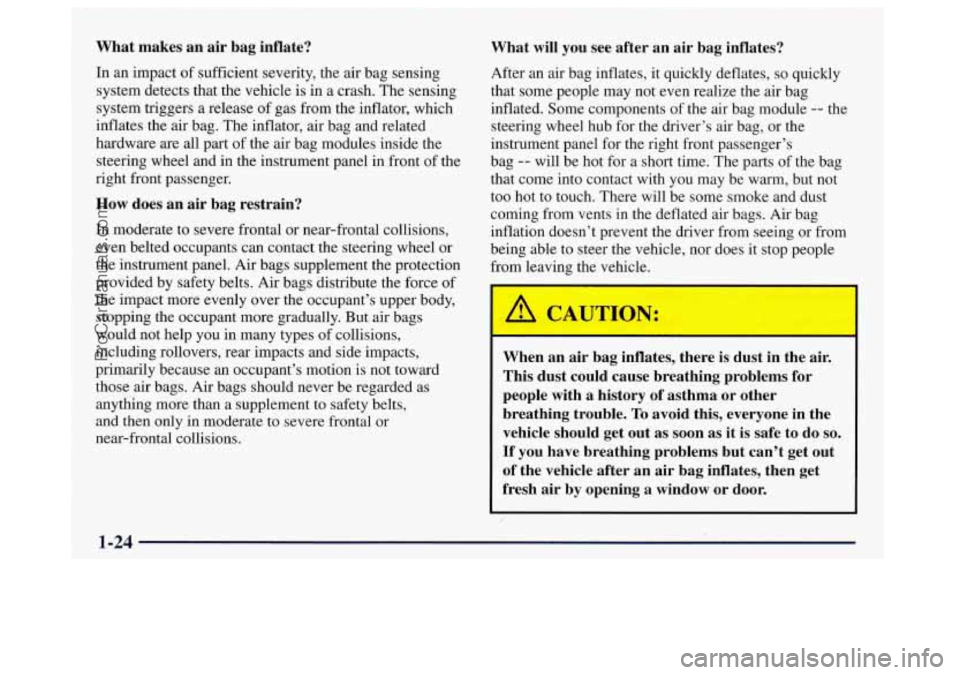
What makes an air bag inflate?
In an impact of sufficient severity, the air bag sensing
system detects that the vehicle is in a crash. The sensing
system triggers a release of gas from the inflator, which
inflates the air bag. The inflator, air bag and related
hardware are all part of the air bag modules inside the
steering wheel and in the instrument panel in front of the
right front passenger.
How does an air bag restrain?
In moderate to severe frontal or near-frontal collisions,
even belted occupants can contact the steering wheel or
the instrument panel. Air bags supplement the protection
provided by safety belts. Air bags distribute the force of
the impact more evenly over the occupant's upper body,
stopping the occupant more gradually. But air bags
would not help you in many types of collisions,
including rollovers, rear impacts and side impacts,
primarily because an occupant's motion is not toward
those air bags. Air bags should never be regarded as
anything more than a supplement to safety belts,
and then only in moderate to severe frontal
or
near-frontal collisions.
What will you see after an air bag inflates?
After an air bag inflates, it quickly deflates, so quickly
that some people may not even realize the air bag
inflated. Some components of the air bag module
-- the
steering wheel hub for the driver's air bag, or the
instrument panel for the right front passenger's
bag
-- will be hot for a short time. The parts of the bag
that come into contact with you may be warm, but not
too hot to touch. There will be some smoke and dust
coming from vents in the deflated air bags. Air bag
inflation doesn't prevent the driver from seeing or from
being able to steer the vehicle, nor does it stop people
from leaving the vehicle.
When an air bag inflates, there is dust in the air.
This dust could cause breathing problems for
people with a history of asthma or other
breathing trouble.
To avoid this, everyone in the
vehicle should get out as soon as it is safe
to do so.
If you have breathing problems but can't get out
of the vehicle after an air bag inflates, then get
fresh air by opening a window or door.
ProCarManuals.com
Page 49 of 380

Child Restraints
Every time infants and young children ride in vehicles, they should have protection provided by appropriate restraints.
What are the different types of add-on
child restraints?
A: Add-on child restraints are available in four basic
types. When selecting a child restraint, take into consideration not only the child's weight and size,
but also whether or not the restraint will be compatible with the motor vehicle in which it
will be used.
An infant car bed
(A) is a special bed made for use
in a motor vehicle. It's an infant restraint system
designed to restrain or position a child on a
continuous flat surface. With an infant car bed,
make sure that the infant's head rests toward the
center of the vehicle.
1-37
ProCarManuals.com
Page 61 of 380

Never do this.
Here two children are wearing the same belt. The
belt can't properly spread the impact forces. In a
crash, the
two children can be crushed together
and seriously injured.
A belt must be used by
only one person at a time.
e: What if a child is wearing a lap-shoulder belt,
but the child is
so small that the shoulder belt is
very close to the child's face
or neck?
A: Move the child toward the center of the vehicle, but
be sure that the shoulder belt still
is on the child's
shoulder.
so that in a crash the child's upper body
would have the restraint that belts provide.
If the
child is sitting
in a rear seat outside position. see
"Rear Safety Belt Comfort Guides"
in the Index. If
the child is so small that the shoulder belt is still
very close to the child's face or neck, you might
want to place the child
in a seat that has a lap belt,
if your vehicle
has one.
1-49
ProCarManuals.com
Page 76 of 380
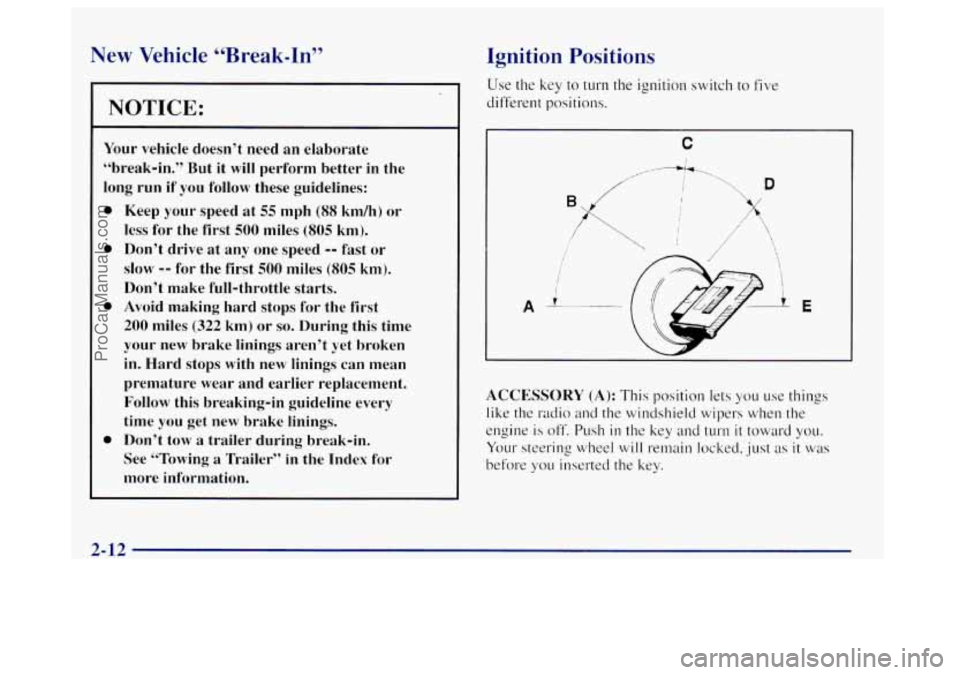
New Vehicle “Break-In”
NOTICE:
Your vehicle doesn’t need an elaborate
“break-in.” But it
will perform better in the
long run if you follow these guidelines:
a
0
a
0
Keep your speed at 55 mph (88 knlhj or
less for the first
500 miles (805 kmj.
Don’t drive at any
one speed -- fast or
slow
-- for the first 500 miles (805 km).
Don’t make full-throttle starts.
Avoid making hard stops for the first
200 miles (322 km) or so. During this time
your new brake linings aren’t yet broken
in. Hard stops with new linings can mean
premature wear and earlier replacement. Follow this breaking-in guideline every
time you get new brake linings.
Don’t tow
a trailer during break-in.
See “Towing a Trailer” in the Index for
more information.
Ignition Positions
Use the key to turn the ignition switch to five
different positions.
C
E
ACCESSORY (A): This position lets you use things
like the radio and
the windshield wipers when the
engine is off. Push in the key and turn it toward you.
Your steering wheel will remain locked, just
as it was
before
yo~l inserted the key.
2-12
- . -~
ProCarManuals.com
Page 77 of 380
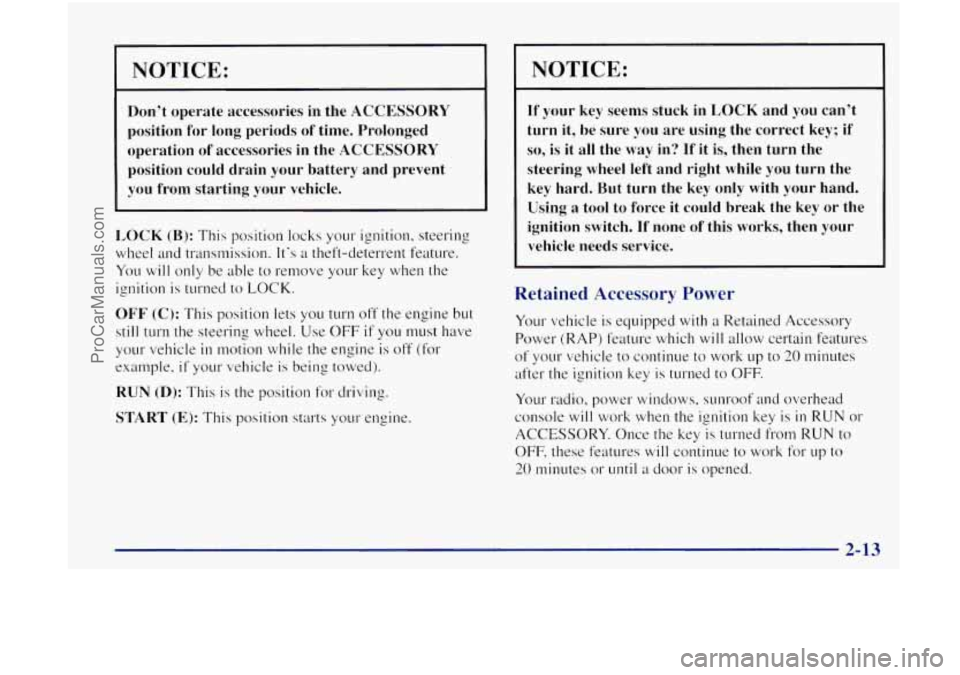
NOTICE:
Don’t operate accessories in the ACCESSORY
position for long periods of time. Prolonged
operation of accessories in the
ACCESSORY
position could drain your battery and prevent
you from starting your vehicle.
LOCK (B): This position locks your ignition, steering
wheel and transmission. It’s
a theft-deterrent feature.
You will only be able to remove your key when the
ignition is turned to
LOCK.
OFF (C): This position lets you turn off the engine but
still turn the steering wheel. Use
OFF if you must have
your vehicle
in motion while the engine is off (for
example,
if your vehicle is being towed).
RUN (D): This is the position for driving.
START (E): This position starts your engine.
NOTICE:
If your key seems stuck in LOCK and you can’t
turn it, be sure you are using the correct key; if
so, is it all the way in? If it is, then turn the
steering wheel left and right while you turn the
key hard. But turn the key only with your hand.
Using
a tool to force it could break the key or the
ignition switch.
If none of this works, then your
vehicle needs service.
Retained Accessory Power
Your vehicle is equipped with a Retained Accessory
Power (RAP) feature which will allow certain features
of your vehicle to continue to work up to 20 minutes
after the ignition
key is turned to OFF.
Your radio, power windows, sunroof and overhead
console
will work when the ignition key is in RUN or
ACCESSORY. Once the key is turned from
RUN to
OFF, these ,features will continue to work for up to
20 minutes or until a door is opened.
ProCarManuals.com
Page 78 of 380

Starting Your Engine
Move your shift lever to PARK (P) or NEUTRAL (N).
Your engine won’t start in any other position -- that‘s a
safety feature. To restart when you’re already moving,
use NEUTRAL
(N) only.
NOTICE:
Don’t try to shift to PARK (P) if your vehicle is
moving. If you do, you could damage the
transmission. Shift to PARK
(P) only when your
vehicle is stopped.
1. Without pushing the accelerator pedal. turn your
ignition key to START. When the engine starts. let
engine gets warm.
2 *o of the key. The idle speed will go down as your
NOTICE:
Holding your key in START for longer than 15
seconds at a time will cause your battery to be
drained much sooner. And the excessive heat can
damage your starter motor.
2. If it doesn’t start right away, hold your key in
START. If it doesn’t start in 10 seconds, push the
accelerator pedal all the way down for five more
seconds, or
until it starts.
3. If your engine still won’t start (or starts but then
stops), wait
15 seconds and start over.
When the engine starts, let
go of the key and the
accelerator pedal.
NOTICE:
Your engine is designed to work with the
electronics
in your vehicle. If you add electrical
parts or accessories, you could change the
way
the engine operates. Before adding electrical
equipment, check with your retailer. If you don’t,
your engine might not perform properly.
If you ever have to have your vehicle towed, see
the part of’this manual that tells how to
do it
without damaging your vehicle. See “Towing
Your Vehicle” in the Index.
2-14
ProCarManuals.com
Page 80 of 380
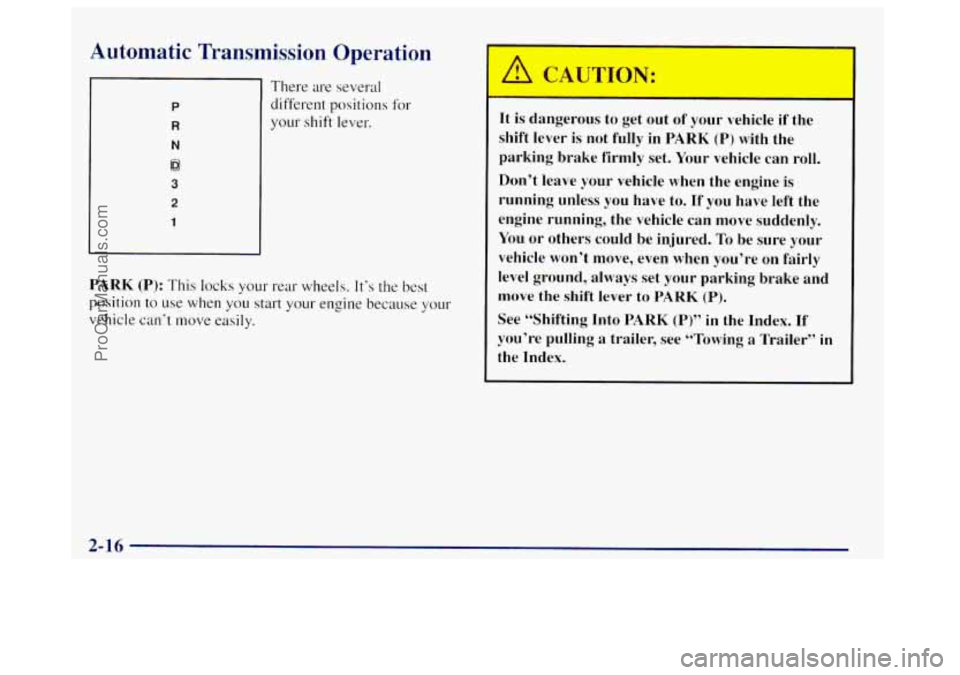
Automatic Transmission Operation
P
R
N
0
3
2
1
There are several
different positions for
your shift lever.
PARK (P): This locks your rear wheels. It’s the best
position to use when you start your engine because your
vehicle
can‘t move easily.
r
It is dangerous to get out of your vehicle if the
shift lever
is not fully in PARK (P) with the
parking brake firmly set. Your vehicle can roll.
Don’t leave your vehicle when the engine is
running unless you have to. If you have left the
engine running, the vehicle can move suddenly.
You or others could be injured. To be sure your
vehicle won’t move, even when you’re
on fairly
level ground, always set your parking brake and
move the shift lever to
PARK (P).
See “Shifting Into PARK (P)” in the Index. If
you’re pulling
a trailer, see “Towing a Trailer” in
the Index.
ProCarManuals.com
Page 82 of 380
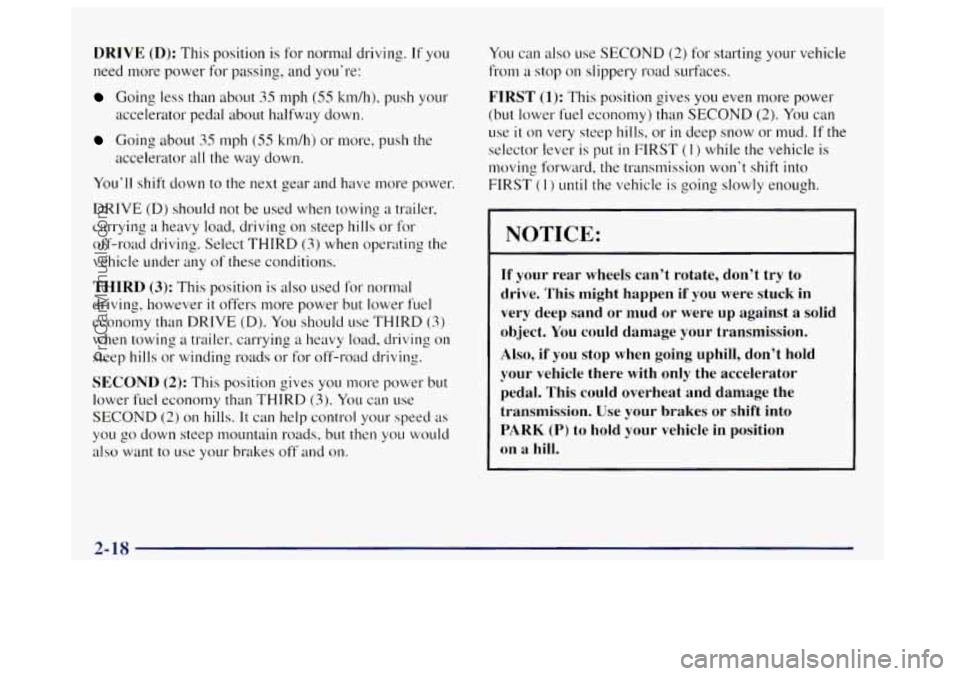
DRIVE (D): This position is for normal driving. If you
need more power for passing, and you’re:
Going less than about 35 mph (5.5 km/h), push your
accelerator pedal about halfway down.
Going about 3.5 mph (5.5 km/h) or more, push the
accelerator all the way down.
You’ll shift down to
the next gear and have more power.
DRIVE (D) should not be used when towing
a trailer,
carrying a heavy load, driving on steep hills or for
off-road driving. Select THIRD
(3) when operating the
vehicle under any of these conditions.
THIRD (3): This position is also used for nornlal
driving, however
it offers more power but lower fuel
economy than DRIVE (D). You should use THIRD
(3)
when towing a trailer, carrying a heavy load, driving on
steep hills or winding roads or for off-road driving.
SECOND (2): This position gives you more power but
lower fuel economy than THIRD
(3). You can use
SECOND
(2) on hills. It can help control your speed as
you go down steep mountain roads, but then you would
also want to use your brakes off and on. You
can also use SECOND
(2) for starting your vehicle
from a stop
on slippery road surfaces.
FIRST (1): This position gives you even more power
(but lower fuel economy) than SECOND
(2). You can
use
it on very steep hills, or in deep snow or mud. If the
selector lever
is put in FIRST (I ) while the vehicle is
moving forward, the transmission won’t shift into
FIRST
(1) until the vehicle is going slowly enough.
-
NOTICE:
If your rear wheels can’t rotate, don’t try to
drive. This might happen if
you were stuck in
very deep sand or mud or were up against a solid
object.
You could damage your transmission.
Also, if you stop when going uphill, don’t hold
your vehicle there with only the accelerator
pedal. This could overheat and damage the
transmission. Use your brakes or shift into
PARK (P) to hold your vehicle in position
on a hill.
2-18
ProCarManuals.com